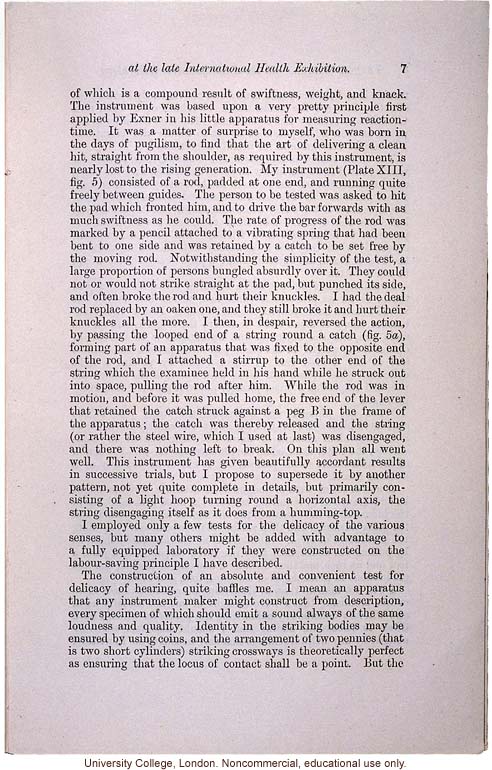at the late International Health Exhibition. 7
of which is the compound result of swiftness, weight, and knack. The instrument was based upon a very pretty principle first applied by Exner in his little apparatus for measuring reaction-time. It was a matter of surprise to myself, who was born in the days of pugilism, to find that the art of delivering a clean hit, straight from the shoulder, as required by this instrument, is nearly lost to the rising generation. My instrument (Plate XIII, fig. 5) consisted of a rod, padded at one end, and running quite freely between guides. The person to be tested was asked to hit the pad which fronted him, and to drive the bar forwards with as much swiftness as he could. The of progress of the rod was marked by a pencil attached to a vibrating spring that had been bent to one side and was retained by a catch to be set free by the moving rod. Notwithstanding the simplicity of the test, a large proportion of person bungled absurdly over it. They could not or would not strike straight at the pad, but punched its side, and often broke the rod and hurt their knuckles. I had the deal rod replaced by an oaken one, and they still broke it and hurt their knuckles all the more. I then, in despair, reversed the action, by passing the looped end of a string round a catch (fig. 5a), forming part of an apparatus that was fixed to the opposite endof the rod, and I attached a stirrup to the other end of the string which the examinee held in his hand while he struck out into space, pulling the rod after him. While the rod was in motion, and before it was pulled home, the free end of the lever that retained the catch struck against a peg B in the frame of the apparatus; the catch was thereby released and the string (or rather the steel wire, which I used at last) was disengaged, and there was nothing left to break. On this plan all went well. This instrument has given beautifully accordant results in successive trials, but I propose to supersede it by another pattern, not yet quite complete in details, but primarily consisting of a light hoop turning round a horizontal axis, the string disengaging itself as it does from a humming-top.
I employed only a few tests for the delicacy of the various senses, but many others might be added with advantage to a fully equipped laboratory if they were constructed on the labour-saving principle I have described.
The construction of an absolute and convenient test for delicacy of hearing quite baffles me. I mean an apparatus that any instrument maker might construct from description, every specimen of which should emit a sound always of the same loudness and quality. Identity in the striking bodies may be ensured by using coins, and the arrangement of two pennies (that is two short cylinders) striking crossways is theoretically perfect as ensuring that the locus of contact shall be a point. But the
[end]


